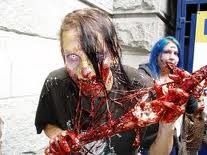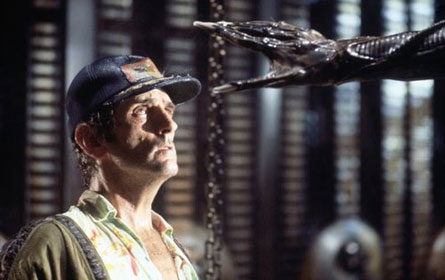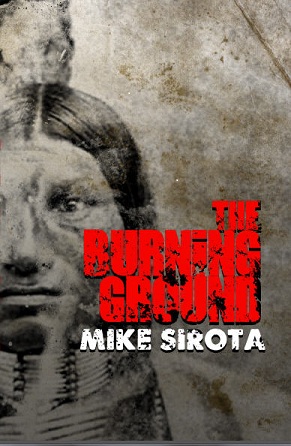I actually taught a class with that exact title some years back. For a long time I served as a consultant for the San Diego Unified School District’s GATE program (Gifted and Talented Education). I’d visit middle grade and high school classrooms, talk about how writers and filmmakers scare people, and show clips from a variety of horror flicks. Needless to say, the class turned out to be one of the more popular presentations within the program. The kids loved it. I only stopped doing it after a parent complained to the district: “Just what are you teaching our children?!” (Lighten up, Francis.) No joke; a teacher friend of mine spent many harrowing months in court after being sued by parents for showing something in his classroom that had already aired on PBS, for crying out loud!
So what did I show the kids in this class? Not zombies chowing down on brains with spoons and straws. Not dozens of body parts hanging from the rafters of a psycho farmer’s barn. Not victims being slowly tortured in one of 5,000 intricate ways. And certainly not some stoner teen emerging from a closet/cellar/air duct/window/you-name-it and clapping a hand on someone’s shoulder. That’s the cheapest “scare” of all.
intricate ways. And certainly not some stoner teen emerging from a closet/cellar/air duct/window/you-name-it and clapping a hand on someone’s shoulder. That’s the cheapest “scare” of all.
I’m “old school” when it comes to scaring people. (Literally and figuratively; I’m turning sixty-six next week—Social Security, baby!—which everyone knows is the new forty-six, so I’ve got a long way to go.) I like the subtle approach, the buildup, the “Oh-my-gosh-something’s-gonna-happen-but-I-don’t-know-what-or-when!” method. For example, the original Alien movie contains one of the most memorable scenes in all of horror movie-dom, when the creature bursts out of John Hurt’s body and scurries away. But the scene I chose to show takes place shortly after, when Harry Dean Stanton’s character walks through the creepy corridors of the spacecraft looking for the cat. You just know something is going to jump out and grab him (or worse), but you don’t know what, or when. The scene, which runs upwards of five minutes, is harrowing as Stanton pokes around corners, pauses to drink some  water (the camera pulls into a close shot of his face for at least fifteen seconds), rummages under and over pipes, and continues to call out to the cat. You probably know what happens—I never showed that scene to the kids—but it’s rather anti-climactic after you’ve spent all that time biting your fingernails down to the nubs. Now that is what I call subtle horror.
water (the camera pulls into a close shot of his face for at least fifteen seconds), rummages under and over pipes, and continues to call out to the cat. You probably know what happens—I never showed that scene to the kids—but it’s rather anti-climactic after you’ve spent all that time biting your fingernails down to the nubs. Now that is what I call subtle horror.
One of the scariest films I’ve ever seen has barely a drop of blood spilled in it. The Changeling, made in 1980, is a classic haunted house movie. George C. Scott plays a composer who, consumed by grief after his wife and daughter are killed in a car accident, moves to a huge, creepy house near Seattle. Some nasty things have happened in this house, and its new resident is learning about them the hard way. The scene I  would show the kids has to do with a rubber ball. In flashbacks we would see Scott’s beloved daughter playing with this ball. Scott keeps it in a box, until one night when, inexplicably on its own, it comes bouncing down the house’s long flight of stairs. Scott picks it up, drives miles from the house, and tosses it into a raging river. He returns home, walks inside—and hears a bouncing noise, one that grows louder and louder as, step by step, the ball again descends the staircase. As I wrote this, I got the willies just thinking about it.
would show the kids has to do with a rubber ball. In flashbacks we would see Scott’s beloved daughter playing with this ball. Scott keeps it in a box, until one night when, inexplicably on its own, it comes bouncing down the house’s long flight of stairs. Scott picks it up, drives miles from the house, and tosses it into a raging river. He returns home, walks inside—and hears a bouncing noise, one that grows louder and louder as, step by step, the ball again descends the staircase. As I wrote this, I got the willies just thinking about it.
With the exception of The Modoc Well, which is a bit gory—but a good story nonetheless—my other three horror novels tend more toward the subtle. In fact, when I submitted Demon Shadows to my editor at Bantam, she told me that “subtle” worked great for the first ten chapters, but I needed to ramp up the gore for the climactic final chapter. My reply: “I can do that.” No problem.
My new novel, The Burning Ground, has a good balance of subtlety and gore, though I believe it still tends toward the former. For example, when Ray Grider first discovers the Maidu burning ground (cemetery), he digs up one of the graves to make certain that the Indians were buried with their possessions before bringing his client to the site. He finds a skeleton, and a flute, and he is elated. He gets drunk and sets up camp for the night on the burning ground. Here is the next scene:
Up on the hillside, the shadow of the Eagle danced over the black plateau. Didn’t make no sense, Grider mused as he rubbed his eyes and pulled himself from the heavy slumber. His fire wasn’t that big, and besides, it wasn’t nowhere near the facing. He got up and staggered toward the rock wall. Standing at the base, he struggled to focus on the Eagle.
All around him flames rose from the earth, yellow-white tendrils that probed the night sky. It was because of them that the Eagle danced. Funny, Grider thought stupidly, he hadn’t noticed them before. They didn’t give off no heat or nothing; tell the truth, he felt…cold.
Suddenly frightened, Grider turned and started back. He nearly stumbled in the hole he’d dug earlier but caught himself, and straddled it.
Down in the hole he heard a clattering sound and saw the skeletal arm reach for the flute with trembling fingers.
Trick of the light, he told himself. But now, after hastily shoveling handfuls of dirt into the hole, he ran across the rest of the burial ground, stopping briefly to stamp out his own small fire, which had begun to die anyway.
Behind him the ground ceased to burn, and the Eagle’s dance was done.
Fuck this; drunk or not, he wasn’t going to stay there any longer. He quickly packed up his things and hurried down the slope to Sugarpine Creek.
Later on, after Grider and his client desecrate the burial ground, they are confronted by…something. Again, the scene is subtle, a buildup to what is about to happen. But a couple of chapters past that, when their remains are discovered, all subtlety has gone out the window.
Much later in the story, when we’ve gotten to know our three main characters—Barry Cordell, Dana Bowen, and ten-year-old Billy Grider—we’re concerned about a request that Billy makes. He asks Barry and Dana to hike with him to the barely accessible meadow in the hills where his father was killed. Unknown to them—but known to the readers— some bizarre and terrible things are taking place there. During the long and emotional scene where Dana and Barry try to help the boy cope with his father’s death, readers know that the trio is walking into a potential nightmare. Though subtle, it is designed to keep those pages turning.
some bizarre and terrible things are taking place there. During the long and emotional scene where Dana and Barry try to help the boy cope with his father’s death, readers know that the trio is walking into a potential nightmare. Though subtle, it is designed to keep those pages turning.
In this extended scene, the trio has sought shelter from a sudden storm in an underground storage chamber once used by the Maidu. Darkness falls, but a bright glow from outside puzzles them, and Barry investigates. Here is the latter part of the scene:
Again he squeezed into the burrow and elbowed his way along the short distance to the opening. He peered outside and for a few seconds forgot to breathe.
Far off, on the granite hillside, the shadow of the Eagle danced.
High atop the slope beyond the other creek, tendrils of flames twisted into the sky.
A fire? Impossible! The rain continued to fall, as it had for a while now. Nothing could burn out there.
Still, the Eagle danced.
“Do you see anything?” Dana asked from below, startling him.
Yes, he saw the flames, and the Eagle, and…
…something else.
It appeared atop the ridge, hovered there briefly then started down the slope. A…wall of mist, Barry thought, lacking any better perspective. Broad—twenty, maybe thirty yards across, but only a fraction of that in height.
In the mist he saw…individual forms.
People? No!
“Barry?” Dana called.
The sounds began, rising in their intensity as the wall of mist floated nearer, sounds that he thought he’d heard…
…sounds that he had heard before.
Wailing.
Cries.
Keening.
Howls.
Sobbing.
Louder now, as the mist drew nearer.
“Barry, please…!”
He scrambled backward, Dana and Billy helping him the last couple of feet. “Who’s out there—?” Dana started to ask.
“Quiet! Don’t say anything!”
They crawled to the side of the burrow, backs pressed firm against the earthen wall as the sounds from above poured into the Fox Hole. Billy cupped his hands over his ears, the adults following his lead. Terror creased their faces—like subjects in a Munch painting, Barry thought insanely.
The sounds piercing their defenses, threatening to shatter their psyches.
Wailing.
Cries.
Keening.
Howls.
Sobbing.
To further tease readers, the scene ends right there and switches to other characters. At least the ensuing scene is gory. But to me, subtlety is always the first option.
My publisher, ZOVA Books, has decided to lower the e-book price of The Burning Ground for Kindle and Nook to a whopping .99 for the month of March. Links are on my Swords and Specters website. Enjoy.

Normally horror, well, horrifies me! But this really talked me into wanting to read it- I’ll have to get it on my Kindle! 🙂
Olivia
Thanks, Olivia. I may be a horror writer but I’m a romantic at heart. Enjoy!
Happy birthday, Mike!!
Moise and Noreen
Thanks. I’m trying to catch up to you guys. 🙂
You successfully scared the bejeezus out of me, more than once. (Yep, that’s a compliment. You’re welcome!)
Blood, gore and violence seem far more powerful to me when they aren’t over done. And the brain is a mighty fine weapon. 🙂 Burning Ground, here I come!
I sleep better at night knowing that I scared the bejeezus out of people. 🙂
Yes, happy birthday, Mike. I wish you all the best in your dotage.
Oh, right. Sixty-six really is the new forty-six, so what does make fifty-four? Tiring, that’s what! I’ve spent my life looking forward to the time when I could wear purple and hit people with my cane and get by with it, like my husband’s grandmother did (for real). With all these new rules about age, I guess I’m expected to act young and responsible until I’m ninety. Darn.
But being fifty-four means I’m old enough to have seen Alien on the big screen, opening night, in San Francisco. That was amazing, and it did scare the crap out of everyone in the packed house. To this day, it’s still my favorite horror film (that just happens to be set in space, as a bonus) for the very reason you pointed out: true nail-biting suspense.
Without the tense buildup, which is hard work to accomplish (either on-screen or on the page) gore, for the sake of supposed shock value, is boring. Not to mention lazy. I’m delighted you believe that, as well. From the excerpts you’ve given us of The Burning Ground, I’m greatly anticipating the fun of ready the copy I have ready and waiting.